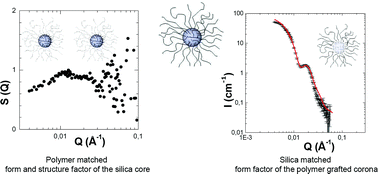We present a new convenient and efficient ‘grafting-from’ method to obtain well-defined polystyrene (PS) silica nanoparticles. The method, based on nitroxide-mediated polymerization (NMP), consists of binding covalently the alkoxyamine (which acts as an initiator controlling agent) to the silica nanoparticles surface in two steps. The first step is a reaction between the aminopropylsilane and the silica particles in order to functionalize the particle surface with an amino group. In a second step, the initiation-controlling alkoxyamine moiety is introduced via an overgrafting reaction between the amino group and the N-hydroxysuccinimide-based MAMA-SG1 activated ester. To simplify both their chemical transformation and the polymerization step, the native silica particles, initially dispersed in water, were transferred to an organic solvent, dimethyl acetamide, which is also a good solvent for the polystyrene. The synthetic parameters were optimized for grafting density, conversion rates, and synthesis reproducibility while keeping the colloidal stability and to avoid any aggregation of silica particles induced by inter-particle interaction during the synthesis. After synthesis, the final grafted objects were purified and the non-grafted polymer chains formed in the solvent washed out by ultra-filtration. The particles were then studied using small-angle neutron scattering (SANS) coupled with a neutron contrast variation method. To optimize the contrast conditions, both hydrogenated and deuterated monomers were used for the synthesis. A refined fitting analysis based on the comparison on two models, a basic core–shell and the Gaussian Pedersen model, enables us to fit nicely the experimental data for both the hydrogenated and deuterated grafted cases. Differences are seen between grafting of normal or deuterated chains, which could be due to monomer reactivity or to neutron contrast effect variations. The synthesis and the characterization method established in this work constitute a robust and reproducible way to design well defined grafted polymer nanoparticles. These objects will be incorporated in polymer matrices in future work to create nanocomposites for polymer reinforcement.

You have access to this article
 Please wait while we load your content...
Something went wrong. Try again?
Please wait while we load your content...
Something went wrong. Try again?


 Please wait while we load your content...
Please wait while we load your content...